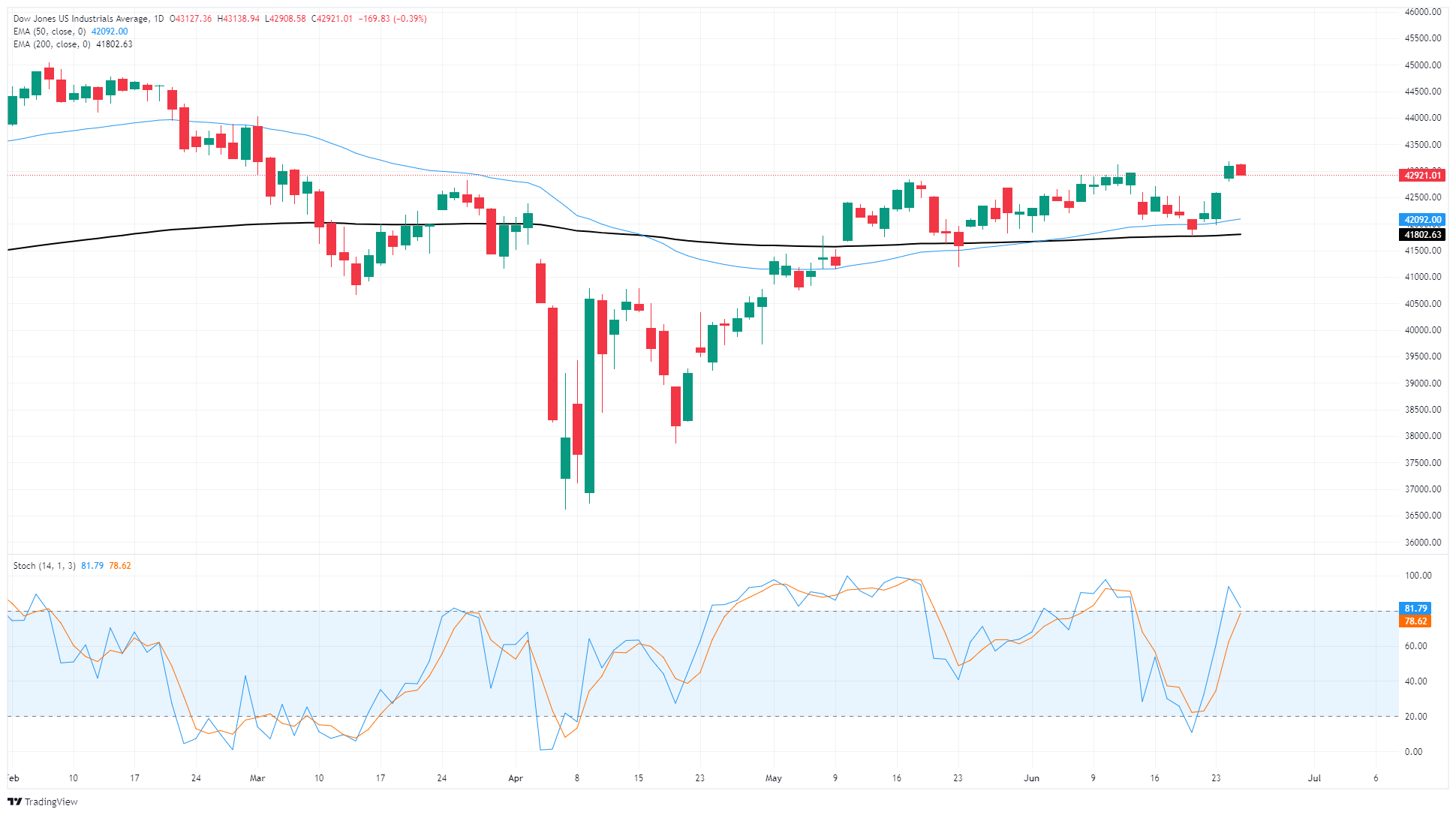Dow Jones Industrial Average holds steady at the top end on Wednesday
- The Dow Jones treaded water on Wednesday, trading within 0.5% of the day’s opening bids.
- Tech stocks continue to rule the risk sentiment roost, bolstering the S&P 500 toward record highs.
- Trump signals more trade tensions, now focused on Spain.
The Dow Jones Industrial Average (DJIA) missed the bullish train on Wednesday, churning chart paper near the 43,000 major price handle as Dow traders ease into a lull after a tense start to the week. Federal Reserve (Fed) Chair Jerome Powell concluded the second of his two-day testimony before the Senate’s financial oversight committee, keeping his commentary firmly on balance and on brand.
US President Donald Trump has turned his trade tariff focus onto Spain as he seeks to get ink to paper on any meaningful trade deals. Trump’s self-imposed deadline before reciprocal tariffs kick back in is fast approaching. The Trump administration has thus far struggled to eke out any trade deals that would represent the windfall to the US economy that he promised in the run-up to April’s “Liberation Day” reciprocal tariffs announcement, which were suspended for 90 days immediately after being announced.
Spain gets latest tariff threats
President Trump announced during his far-ranging comments at the NATO 2025 summit in The Hague that Spain would “pay twice as much”, claiming that US delegates were actively negotiating with Spain. Trump also stated that he would negotiate with Spain directly and reiterated that “Spain is going to pay,” implying that the Trump administration is still working to find a way to make foreign countries pay the import taxes on goods that cross into the US.
The Standard & Poor’s 500 (SP500) major equity index is within 1% of record highs, drawing investor focus as traders wait for meaningful developments in economic data or macro headline flows. Nvidia (NVDA), the de facto shovel-seller in the AI gold rush, is up over 3% on Wednesday and also within inches of all-time highs.
Read more stock news: Nvidia stock nears all-time high after Loop Capital hikes price target
Dow Jones price forecast
The Dow Jones Industrial Average tested its highest bids in three months this week, butr a near-term consolidation zone is keeping the major average pinned close to the 43,000 handle. The Dow has chalked in another bullish technical rejection of the 200-day Exponential Moving Average (EMA) near 41,800. However, top-side momentum could be due for a breather as technical oscillators test overbought territory.
Dow Jones daily chart

Dow Jones FAQs
The Dow Jones Industrial Average, one of the oldest stock market indices in the world, is compiled of the 30 most traded stocks in the US. The index is price-weighted rather than weighted by capitalization. It is calculated by summing the prices of the constituent stocks and dividing them by a factor, currently 0.152. The index was founded by Charles Dow, who also founded the Wall Street Journal. In later years it has been criticized for not being broadly representative enough because it only tracks 30 conglomerates, unlike broader indices such as the S&P 500.
Many different factors drive the Dow Jones Industrial Average (DJIA). The aggregate performance of the component companies revealed in quarterly company earnings reports is the main one. US and global macroeconomic data also contributes as it impacts on investor sentiment. The level of interest rates, set by the Federal Reserve (Fed), also influences the DJIA as it affects the cost of credit, on which many corporations are heavily reliant. Therefore, inflation can be a major driver as well as other metrics which impact the Fed decisions.
Dow Theory is a method for identifying the primary trend of the stock market developed by Charles Dow. A key step is to compare the direction of the Dow Jones Industrial Average (DJIA) and the Dow Jones Transportation Average (DJTA) and only follow trends where both are moving in the same direction. Volume is a confirmatory criteria. The theory uses elements of peak and trough analysis. Dow’s theory posits three trend phases: accumulation, when smart money starts buying or selling; public participation, when the wider public joins in; and distribution, when the smart money exits.
There are a number of ways to trade the DJIA. One is to use ETFs which allow investors to trade the DJIA as a single security, rather than having to buy shares in all 30 constituent companies. A leading example is the SPDR Dow Jones Industrial Average ETF (DIA). DJIA futures contracts enable traders to speculate on the future value of the index and Options provide the right, but not the obligation, to buy or sell the index at a predetermined price in the future. Mutual funds enable investors to buy a share of a diversified portfolio of DJIA stocks thus providing exposure to the overall index.

